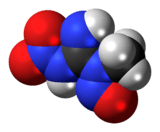Methylnitronitrosoguanidine
Methylnitronitrosoguanidine (MNNG or MNG) is a biochemical tool used experimentally as a carcinogen and mutagen.[1] It acts by adding alkyl groups to the O6 of guanine and O4 of thymine, which can lead to transition mutations between GC and AT. These changes do not cause a heavy distortion in the double helix of DNA and thus are hard to detect by the DNA mismatch repair system.
 | |
 | |
| Names | |
|---|---|
| Preferred IUPAC name
N-Methyl-N'-nitro-N-nitrosoguanidine | |
| Other names
1-Methyl-3-nitro-1-nitrosoguanidine N-Methyl-N-nitroso-N′-nitroguanidine | |
| Identifiers | |
3D model (JSmol) |
|
| Abbreviations | MNNG |
| ChemSpider | |
| ECHA InfoCard | 100.000.664 |
| KEGG | |
PubChem CID |
|
| UNII |
|
CompTox Dashboard (EPA) |
|
| |
| |
| Properties | |
| C2H5N5O3 | |
| Molar mass | 147.09 g/mol |
| Appearance | Yellow crystals |
| Melting point | 118 °C (244 °F; 391 K) (decomposes) |
| reacts violently, slowly hydrolysed | |
Except where otherwise noted, data are given for materials in their standard state (at 25 °C [77 °F], 100 kPa). | |
| Infobox references | |
One of the earliest uses of methylnitronitrosoguanidine was in 1985. A group of scientists tested whether or not the chemical composition of methylnitronitrosoguanidine would directly affect the growth of tumors and cancer cells in rats.
In the experiment, the cancer cells from a Japanese cancer patient was injected into 8 rats. The biochemical tool and showed a decline of cancer cells in a few of the rats' bodies.
In organic chemistry, MNNG is used as a source of diazomethane when reacted with aqueous potassium hydroxide.[2]
MNNG is a probable human carcinogen listed as an IARC Group 2A carcinogen.[3]
References
- Merck Index, 11th Edition, 6017.
- T. Howard Black (1983). "The Preparation and Reactions of Diazomethane" (PDF). Aldrichimica Acta. 16 (1).
- N-METHYL-N'-NITRO-N-NITROSOGUANIDINE (MNNG), International Agency for Research on Cancer